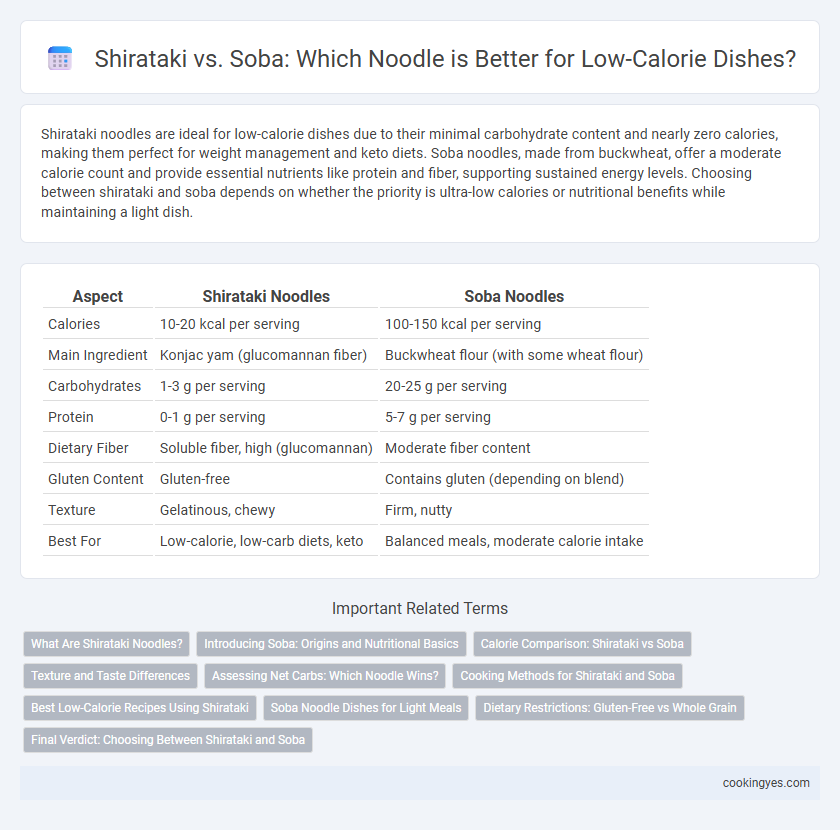Shirataki noodles are ideal for low-calorie dishes due to their minimal carbohydrate content and nearly zero calories, making them perfect for weight management and keto diets. Soba noodles, made from buckwheat, offer a moderate calorie count and provide essential nutrients like protein and fiber, supporting sustained energy levels. Choosing between shirataki and soba depends on whether the priority is ultra-low calories or nutritional benefits while maintaining a light dish.
Table of Comparison
| Aspect | Shirataki Noodles | Soba Noodles |
|---|---|---|
| Calories | 10-20 kcal per serving | 100-150 kcal per serving |
| Main Ingredient | Konjac yam (glucomannan fiber) | Buckwheat flour (with some wheat flour) |
| Carbohydrates | 1-3 g per serving | 20-25 g per serving |
| Protein | 0-1 g per serving | 5-7 g per serving |
| Dietary Fiber | Soluble fiber, high (glucomannan) | Moderate fiber content |
| Gluten Content | Gluten-free | Contains gluten (depending on blend) |
| Texture | Gelatinous, chewy | Firm, nutty |
| Best For | Low-calorie, low-carb diets, keto | Balanced meals, moderate calorie intake |
What Are Shirataki Noodles?
Shirataki noodles are thin, translucent strands made from the konjac yam, containing virtually zero calories and carbohydrates, making them an ideal choice for low-calorie dishes. Unlike soba noodles, which are derived from buckwheat and contain higher calories and carbs, shirataki noodles offer a gelatinous texture and absorb flavors without adding significant nutritional load. Their high fiber content, specifically glucomannan, aids digestion and promotes satiety, enhancing their appeal in calorie-conscious meals.
Introducing Soba: Origins and Nutritional Basics
Soba noodles originate from Japan and are traditionally made from buckwheat flour, providing a rich source of protein, fiber, and essential minerals like manganese and magnesium. Compared to shirataki, which is primarily composed of konjac yam and extremely low in calories, soba offers a balanced nutritional profile with moderate calories and complex carbohydrates. These attributes make soba an ideal choice for low-calorie dishes that also deliver sustained energy and vital nutrients.
Calorie Comparison: Shirataki vs Soba
Shirataki noodles contain approximately 10-20 calories per serving, making them one of the lowest-calorie noodle options available, ideal for weight management and calorie-restricted diets. In contrast, soba noodles, made from buckwheat, typically have around 100-200 calories per serving depending on portion size, offering a moderate calorie content with added protein and fiber benefits. Choosing Shirataki over soba significantly reduces calorie intake in noodle dishes, supporting low-calorie meal planning without sacrificing texture or volume.
Texture and Taste Differences
Shirataki noodles boast a gelatinous, chewy texture with a neutral taste, making them ideal for absorbing flavorful sauces in low-calorie dishes. Soba noodles offer a slightly firm bite and a nutty, earthy flavor thanks to their buckwheat content, which adds depth to light meals without extra calories. Texture-wise, Shirataki is slippery and translucent, while Soba is more substantial and opaque, influencing the sensory experience of each dish.
Assessing Net Carbs: Which Noodle Wins?
Shirataki noodles contain virtually zero net carbs due to their high glucomannan fiber content, making them ideal for low-calorie and low-carb diets. Soba noodles, though lower in calories compared to traditional pasta, have approximately 20 grams of net carbs per serving, influenced by their buckwheat flour base. For those prioritizing minimal net carb intake, shirataki noodles clearly surpass soba, offering a superior option for weight management and glycemic control.
Cooking Methods for Shirataki and Soba
Shirataki noodles require thorough rinsing and boiling for 2-3 minutes to remove their natural odor before stir-frying or adding to soups, ensuring a chewy texture ideal for low-calorie dishes. Soba noodles, made from buckwheat, should be boiled for 4-5 minutes until tender, then rinsed under cold water to prevent clumping and maintain firmness, making them versatile for salads or hot broths. Proper preparation of both noodles enhances their flavor absorption and texture while aligning with calorie-conscious meal plans.
Best Low-Calorie Recipes Using Shirataki
Shirataki noodles, made from konjac yam, contain about 20 calories per serving, making them significantly lower in calories compared to soba noodles, which have around 100 calories per serving. Their gelatinous texture absorbs flavors well, making them ideal for low-calorie stir-fries, soups, and salads. Popular recipes include Shirataki noodle stir-fry with garlic and vegetables, Shirataki noodle miso soup, and cold Shirataki noodle salad with sesame dressing, all offering satisfying, nutrient-friendly meals.
Soba Noodle Dishes for Light Meals
Soba noodles, made from buckwheat flour, offer a nutritious and low-calorie option for light meals, providing complex carbohydrates and essential amino acids. Unlike Shirataki noodles, which are primarily water and fiber with minimal calories, Soba noodles deliver more balanced energy and a satisfying texture, making them ideal for wholesome, calorie-conscious dishes. Incorporating Soba noodles in salads, soups, or cold dishes enhances flavor while maintaining a light, nutritious profile suitable for weight management and balanced diets.
Dietary Restrictions: Gluten-Free vs Whole Grain
Shirataki noodles are an excellent choice for low-calorie dishes as they are naturally gluten-free and made from konjac yam, suitable for individuals with gluten intolerance or celiac disease. In contrast, soba noodles, typically made from buckwheat flour, offer whole grain benefits and higher protein content but may contain wheat, posing a risk for those avoiding gluten. Selecting shirataki supports strict gluten-free diets, while soba provides more fiber and essential nutrients for those without gluten restrictions.
Final Verdict: Choosing Between Shirataki and Soba
Shirataki noodles, made from konjac yam, contain virtually zero calories and carbohydrates, making them ideal for strict low-calorie diets, while soba noodles, composed primarily of buckwheat, offer a moderate calorie count with added protein and fiber benefits. Selecting between shirataki and soba depends on dietary goals: choose shirataki for near-zero caloric intake and minimal carbs, or opt for soba when seeking a nutrient-rich option with balanced calories that supports weight management. Both noodles serve distinct roles in low-calorie dishes, with shirataki excelling in calorie control and soba providing essential nutrients and satiety.
Shirataki vs Soba for Low-calorie Dishes Infographic

 cookingyes.com
cookingyes.com